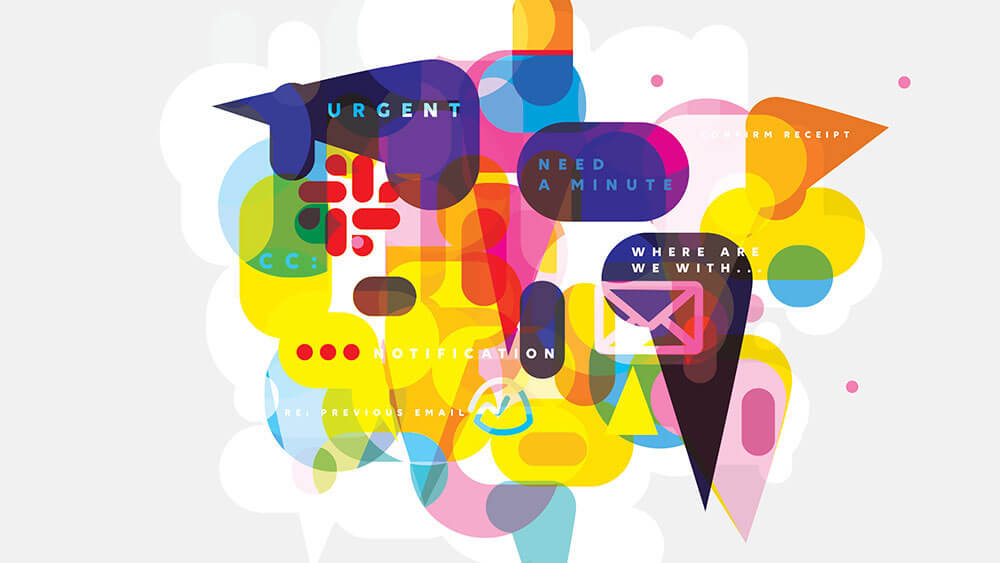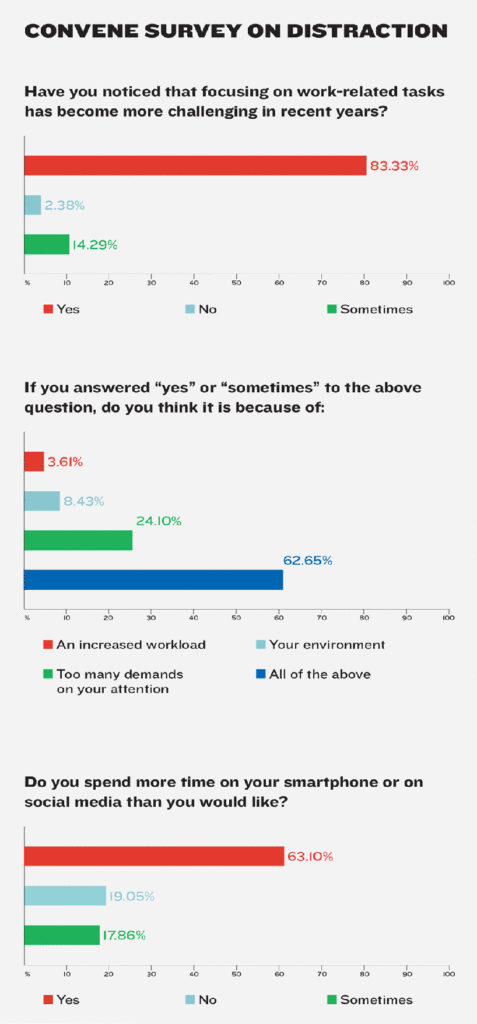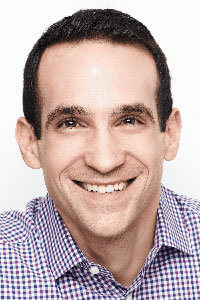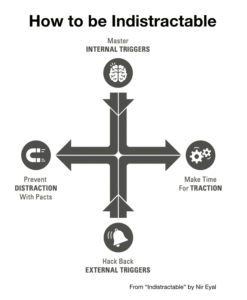
With so many distractions popping up during work, staying focused is becoming more difficult than ever. But there are some fixes. (Andrew Bannecker illustration)
Picture this: You arrive at your desk ready for the day, power up your laptop, and write out a short list of tasks you need to accomplish — maybe even one project or report that needs your full attention. You start in. Ding. You’ve got a text about an upcoming meeting from your coworker: You going? You no sooner text back “yes” with an eye-rolling emoji than you get a ping on your laptop. It’s your email notifying you of a new message. It’s marked urgent, so you open your inbox and you see that a bunch of new emails have already started to pile up, some with that anxiety-producing red exclamation mark.
While you’re tapping out your response to the need-to-know-now email, you hear a new sound. What’s that? Oh, look: You’ve got a question from your colleague on Slack. You shoot back a quick answer and realize that you’ve gotten a new update about a project on Basecamp. Plus, a reminder just slithered across the top of your screen: Someone has assigned you a task on Asana that seems to be overdue. Meanwhile, beep: Another coworker is trying to chat with you on Skype, and at the same time you get a reminder that you have a Zoom meeting in 15 minutes.
You put out the fires, participate in an unproductive conference call, and go back to the project at hand. But you’re finding it hard to concentrate. You can’t help but overhear snippets of conversations going on in your open-space office. Maybe what you need is a little mental break. So you check your Facebook feed, and see what’s trending on Twitter and new on Instagram.
And so it goes for the rest of the day, one distraction after the next — some you instigate yourself, and others you feel a victim to, powerless to ignore. When you leave for home, it sure feels like you’ve put in a full day, but you also have the nagging sense that you’ve accomplished little of substance. And, no surprise, none of those to-do items got checked off your list.
Judging from a recent Convene short survey, this workday scenario requires no imagination on your part. It’s your — and almost all knowledge workers’ — everyday reality. “As much as I try to stay focused by making a to-do list every morning,” one respondent wrote, “it doesn’t take long before a new to-do becomes a priority over what is already on my list. It’s usually downhill from there.”
 When we asked event professionals if they’ve noticed that focusing on work-related tasks has become more challenging in recent years, only two — out of 83 participants — said no. Eighty-three percent said yes, and 14 percent said sometimes.
When we asked event professionals if they’ve noticed that focusing on work-related tasks has become more challenging in recent years, only two — out of 83 participants — said no. Eighty-three percent said yes, and 14 percent said sometimes.
RELATED: How Event Professionals Stay Focused on the Job
Which makes our meeting planners an even more distracted bunch than the 70 percent of workers who said they are distracted at work in a Udemy Research study conducted last year. The fact that 98 percent of people responding to Convene’s survey cited workplace distraction as more of a problem recently came as something of a surprise even to Nir Eyal, who has spent years studying the intersection of psychology, technology, and how we engage with it. Eyal — who calls becoming “indistractable” the most important skill for the 21st century — devoted five years to writing his recent book, Indistractable: How to Control Your Attention and Choose Your Life.
Five years? Yes, he admitted in a recent interview with Convene. “It took me five years,” he said, “because I kept getting distracted.” The end result is a book that shares Eyal’s hard-won efforts to keep distractions under control in order to accomplish the goals you set for yourself. Each chapter is deliberately short and includes “Remember This” bullet points at the end, because “if you’re writing a book about distraction,” he told Convene, “you should make sure your readers aren’t easily distracted.”
WHAT’S GOING ON HERE?
“When you invent the ship, you also invent the shipwreck,” writes the French philosopher Paul Virilio. “When you invent the plane,” his quote continues, “you also invent the plane crash; and when you invent electricity, you invent electrocution. … Every technology carries its own negativity, which is invented at the same time as technical progress.”

Nir Eyal
It’s a quote that Eyal refers to in his book, to underscore how we can let the technology that is meant to serve us — to make us more efficient, more organized, more connected — become our master.
We can blame part of that on tech tools’ persuasive design, deliberately intended to change our behavior — to make us “Pavlovian in our compulsive need to answer email/texts, and monitor Twitter/Facebook updates,” writes Brian Solis, principal at research firm Altimeter Group, which focuses on disruptive technology. “Even worse,” he continues in a World Economic Forum post, “we have reached a point where getting back on track requires slow, deliberate daily practice for us to relearn how to focus.”
The fact that products are designed to be engaging is something that Eyal acknowledges, but he says addictive technology isn’t the only force at work here. While there are certainly more communication channels and apps that can sidetrack us and cause us to lose focus, Eyal pointed out that distraction is not a new problem — 2,500 years ago, Plato talked about the tendency we all have to do things against our better interests. In other words, yes, there is more digital stuff competing for our attention, but we also are predisposed to allow things to steal our focus.
THE OPPOSITE OF DISTRACTION
The best way to understand what distraction is, Eyal told Convene, “is to understand what distraction is not. The opposite of distraction is traction. Traction is any action that pulls us toward things that we want to do, things that we do with intent. Distraction is anything that pulls us away from what we want to do.”
There are both internal and external triggers at work here. “Internal triggers cue us from within,” Eyal writes in Indistractable. “When we feel our belly growl, we look for a snack.” On the other hand, external triggers are environmental cues “that tell us what to do next, like the pings, dings, and rings that prompt us to check our emails, open a news alert, or answer a phone call. External triggers also can take the form of other people, such as a coworker who stops by our desk.”
RELATED: Open Office Space, the Breeding Ground for Distractions
We are currently facing “a trifecta of distraction,” he writes: “the amount of information available, the speed at which it can be disseminated, and the ubiquity of access to new content on our devices.”
Despite those environmental siren calls, Eyal maintains that the most common source of distraction comes from within: It’s the internal triggers, the uncomfortable emotional states from which we seek escape. “Everything we do is for one reason: to escape from discomfort,” he said in a recent livestreamed talk at an RSA event in London. “We go to Facebook when we’re feeling lonely, if we’re feeling uncertain we go to Google, when we’re bored, we check YouTube and Pinterest.”
WHAT’S THE SOLUTION?
We have to “hack back” to gain control over our day, Eyal said. “Time management is pain management,” he writes. “You have to make time for traction.” Two-thirds of workers don’t keep any sort of schedule, he told the RSA audience. “We keep our stuff safe, but when it comes to our time, we let anyone come in and steal it away from us. If you don’t plan your time, someone is going to plan it for you.”
 Among other strategies, Eyal recommends taking back your time by doing the following.
Among other strategies, Eyal recommends taking back your time by doing the following.
- Timebox your day.
Allocate a block of time that you’ll spend on certain tasks. Instead of working on the task until it’s done, you proactively decide how much time you’ll spend on it and when. “The purpose of a timebox calendar isn’t to punish yourself,” he told the RSA audience. Eyal organizes his own calendar in 30-minute increments, he said, and he puts time in for things that are otherwise considered distractions. “For example,” he said, “in my calendar every day, I have time for social media. Two benefits to putting time in my calendar for social media are that one, I’ve taken the distraction that I used to use throughout the day and … turned it into something that I plan to do with intent. The other benefit is that I don’t constantly have to think about when I’m going to do it. The stress that would otherwise prompt me to check all day is extinguished.”
- Wrestle control of email.
It’s the No. 1 source of distraction, yet most emails we send and receive are not urgent, he writes. It’s “our brain’s weakness for variable rewards [that] makes us treat every message, regardless of form, as if it’s time sensitive. That tendency conditions us to check constantly, return replies, and bark out whatever requests come to mind instantaneously. These are all mistakes.”
Of course, if your work culture requires that you respond quickly to emails, you may have more of a difficult time hacking back email the way Eyal suggests: Instead of playing email ping pong, set up a schedule to let people book a slot to speak with you. And delay responding: Fewer emails sent per day results in fewer emails sent back per day.
“Only touch each email twice,” he writes. “When you first open an email, answer this question before closing it: When does it require a response? Then, tag it either ‘Today’ or ‘This Week.’”
RELATED: Why Email is so Exhausting — and What You Can do About It
- Master your smartphone.
Eyal recommends uninstalling the apps you no longer use, and shifting some, like social media and YouTube, to your desktop instead of on your smartphone. Wearing a wristwatch instead of constantly checking your phone for the time creates less of a distraction, as does moving any apps that may trigger mindless checking from your phone’s home screen. Finally, change the notification settings — “Be very selective,” Eyal writes, “regarding which apps can send you sound and sight cues.”
- Part of the solution to tech distraction is other tech.
Pocket, for example, is an app that lets you save interesting articles to read — or listen to — later. Another free technology called Todobook replaces the Facebook News Feed with the user’s to-do list. Instead of scrolling the feed, Eyal writes, “we see tasks that we planned to do for the day, and only when we’ve completed our to-do list does the News Feed unlock.” There are other apps like SelfControl, Forest, and Focusmate that can help you facilitate pacts with other workers where you commit to doing focused work at the same time, something Eyal found kept him on course as he was writing the book.
- Let coworkers know you are not to be disturbed.
Indistractable includes a card-stock insert — a simple sign that you place on your monitor that says: “I’m indistractable at the moment. Please do not disturb unless it’s really important.”
Any kind of signal that you aren’t available to chat can make a difference between sloppy and thoughtful work. Eyal cites a multi-hospital study coordinated by the University of California, San Francisco, in which nurses who wore bright orange vests when they were dispensing medications — a visual cue for others not to interrupt them — had an 88-percent decrease in their error rate.
Of course, you can’t go it alone. Organizations, Eyal said, need to give employees “psychological safety” — the ability to talk about the difficulty of fielding distractions, technology overuse, and the expectation of being on 24/7. “The most important factor is a company culture where management exemplifies what it means to be indistractable,” he told the RSA audience. “Culture flows downhill.”
Michelle Russell is Convene’s editor in chief.
RELATED: Helping Attendees Avoid Distractions at Events
Earn One Hour of CE Credit
By reading this story, its related stories at the links above, and listening to accompanying material linked below, you will be ready to earn one hour of CE credit toward CMP certification from the Events Industry Council.
- Once you’ve finished reading this article, listen to a 25-minute Accidental Creative podcast with Deep Work author Cal Newport on how to focus — what he calls “the new IQ” — without distraction.
To take an online test to earn CE credit, and for access to additional CMP Series stories, go to our CMP Series page.
The Certified Meeting Professional (CMP) is a registered trademark of the Events Industry Council.
Nir Eyal Speaks at an RSA Event in London
This story originally was published Dec. 1, 2019.
